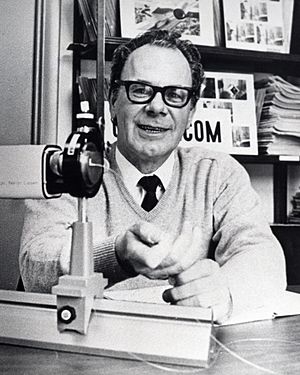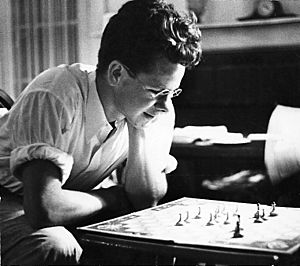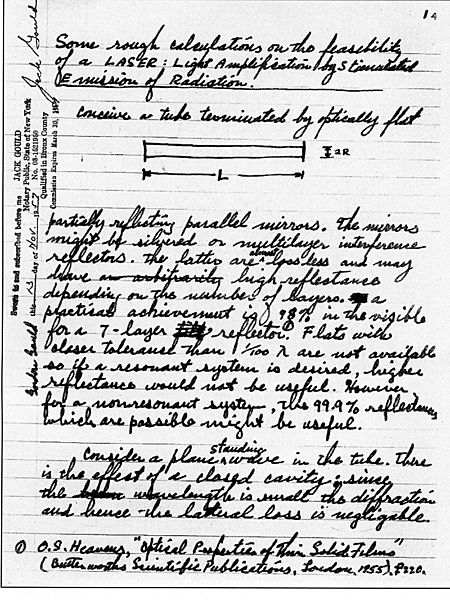Gordon Gould facts for kids
Quick facts for kids
Gordon Gould
|
|
|---|---|
 |
|
| Born |
Richard Gordon Gould
July 17, 1920 |
| Died | September 16, 2005 (aged 85) New York City
|
| Nationality | American |
| Alma mater | Union College (BS) Yale University (MS) Columbia University (PhD) |
| Known for | Laser, patent law |
| Scientific career | |
| Fields | Physics |
| Institutions | NYU Poly |
Richard Gordon Gould (born July 17, 1920 – died September 16, 2005) was an American physicist. He is often recognized for inventing the laser and the optical amplifier. While the invention of the laser is debated, Gould is famous for his long, thirty-year battle to get patents for his laser ideas and related technologies. He also fought in court to make sure companies used his patents fairly.
Contents
Early Life and Education
Gordon Gould was born in New York City. He was the oldest of three brothers. His father helped start Scholastic Magazine Publications. Gordon grew up in Scarsdale, a suburb of New York.
He studied physics at Union College and earned a bachelor's degree. Then, he got a master's degree from Yale University. He focused on optics, which is the study of light, and spectroscopy, which looks at how light interacts with matter.
Between 1944 and 1945, he worked on a secret government project. However, he had to leave because of some past activities. In 1949, Gould went to Columbia University to work on his PhD. He studied how to use light to "pump" energy into atoms. This technique is called optical pumping.
In 1956, Gould thought about using optical pumping to improve a device called a maser. A maser is like a laser, but it works with microwaves instead of light. He talked about his idea with Charles Hard Townes, who invented the maser. Townes later won a Nobel Prize for his work on masers and lasers.
How Gordon Gould Thought of the Laser
By 1957, many scientists, including Charles Townes, wanted to find a way to make a maser work with visible light. In November of that year, Gould had a big idea. He realized he could use two mirrors to create a special light box. This box would make a very focused and strong beam of light. This was different from earlier ideas.
Gould wrote down all his ideas and how this new device could be used in his notebook. He titled it: "Some rough calculations on the feasibility of a LASER: Light Amplification by Stimulated Emission of Radiation." This was the first time the word LASER was ever used! He knew his idea was important, so he took his notebook to a store to have it officially witnessed.
About three months later, other scientists, Arthur Leonard Schawlow and Charles Townes, also figured out the importance of the mirror setup. They called their idea an "optical maser." But Gould's name, "laser," was first shared at a conference in 1959. It soon became the common name for the device.
Gould was eager to get a patent for his invention. He thought he needed to build a working laser first. So, he left Columbia University before finishing his degree. He joined a research company called TRG. He convinced TRG to support his research. They even got money from the government for the project.
However, the government declared the project a secret. This meant special permission was needed to work on it. Because of his past activities, Gould could not get this permission. He stayed at TRG, but he couldn't directly work on building his own laser. Due to technical problems and Gould's limited involvement, another scientist named Theodore Maiman built the first working laser at Hughes Research Laboratories.
Fighting for Patents
Around this time, Gould and TRG started applying for patents for Gould's laser ideas. In April 1959, they filed their first applications. These covered many laser technologies, like how to make the laser light strong and how to use it for things like measuring distance or communicating.
However, Schawlow and Townes had already applied for a laser patent in July 1958. Their patent was granted in March 1960. Gould and TRG challenged this. They used Gould's 1957 notebook as proof that he had the idea first. At that time, the U.S. patent system gave patents to the person who invented something first, not necessarily the first to apply.
Gould eventually lost the battle for the main U.S. patent on the laser itself. One reason was that his notebook didn't clearly state that the sides of the laser material should be transparent. Also, there were questions about whether his notebook had enough information for someone to actually build a laser. Even Gould's own team at TRG couldn't build one at the time. However, Gould did get patents for the laser in several other countries. He continued to fight for U.S. patents on specific laser technologies for many years.
In 1967, Gould left TRG and became a professor at the Polytechnic Institute of Brooklyn. He came up with many new ways to use lasers there.
Gould's first U.S. laser patent was granted in 1968. It was for a less common use: creating X-rays with a laser. This patent was important because it contained many of his original ideas from 1959. This helped the patent office reject other patent applications that were similar to Gould's pending ones. The legal battles continued, with many inventors trying to claim credit for different laser technologies. Even today, historians still debate who should get full credit for inventing the laser.
By 1970, TRG was sold to another company. This new company wasn't interested in lasers. Gould was able to buy back his patent rights for just a thousand dollars. He also agreed to give them a small part of any future profits.
In 1973, Gould left the Polytechnic Institute to help start a company called Optelecom. This company made equipment for fiberoptic communication, which uses light to send information. He later left this successful company in 1985.
More Patent Fights and Winning Royalties
Soon after starting Optelecom, Gould and his lawyers changed their plan. They had lost many court cases about the laser itself. So, they decided to focus on the optical amplifier. This is a key part of any laser.
This new plan worked! In 1977, Gould was granted a patent for optically pumped laser amplifiers. By then, the laser industry was making about $400 million a year. They didn't want to pay royalties (money for using the invention) for technology they had been using for years. So, they fought in court to avoid paying.
The industry's protests made the patent office slow down on releasing Gould's other patents. This led to more appeals and changes to his pending patents. Still, in 1979, Gould received another patent. This one covered many laser uses, like heating, welding, cutting, measuring distance, communication, and even laser photocopiers. The industry again responded with lawsuits to avoid paying for this patent. Also in 1979, Gould and his financial supporters started a company called Patlex. This company would hold the patent rights and handle licensing and enforcement.
The legal battles went on. The laser industry tried to stop the Patent Office from giving Gould more patents. They also tried to cancel the patents he already had. Gould and his company had to fight in both court and in Patent Office reviews.
Things finally started to change in 1985. After years of legal fighting, a court ordered the Patent Office to issue Gould's patent for collisionally pumped laser amplifiers. The Patent Office appealed, but they eventually had to issue the patent. They also had to stop trying to cancel Gould's earlier patents. Another important patent, related to controlling light polarization, was issued later.
Once the Patent Office actions ended, Gould's lawsuits to enforce his patents could move forward. Finally, in 1987, Patlex won its first big victory against a laser manufacturer. Instead of going bankrupt, the company turned over its ownership to Patlex as part of a deal. Other laser companies and users quickly agreed to settle their cases and get licenses from Patlex.
The thirty-year "patent war" that Gould fought became one of the most famous patent battles in history. In the end, Gould received forty-eight patents. The patents for optical pumping, collisional pumping, and laser applications were the most important. Together, these covered most of the lasers used at the time. For example, the first working laser used optical pumping.
Because of the long delay, lasers became very common in many technologies. This meant the patents were much more valuable than if Gould had won early on. Even though Gould had given away 80% of his future earnings to pay for his court costs, he still made several million dollars.
A scientist named William R. Bennett, Jr., who helped build one of the first continuous lasers, said, "I thought that he legitimately had a right to the notion to making a laser amplifier. He was able to collect royalties from other people making lasers, including me."
Hall of Fame and Death
Even though his role in inventing the laser was debated for decades, Gordon Gould was chosen for the National Inventors Hall of Fame in 1991.
Gould passed away from natural causes on September 16, 2005. At the time of his death, the debate about his exact role in the laser's invention continued. However, Gould did live long enough to see his last important patent expire in May 2005, just as he had hoped.
See also
 In Spanish: Gordon Gould para niños
In Spanish: Gordon Gould para niños
- Robert Kearns, another inventor who fought a long battle to enforce his patents.
- Edwin H. Armstrong, another inventor who fought a long and difficult battle to enforce his patents.



